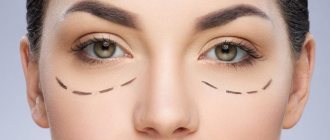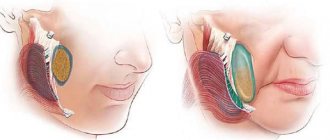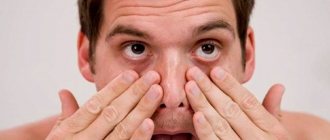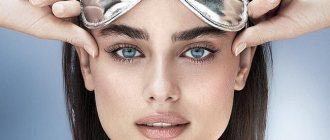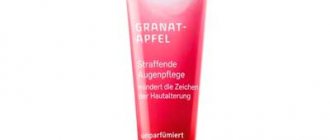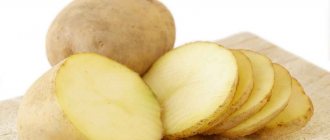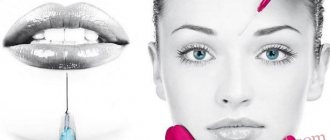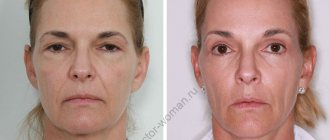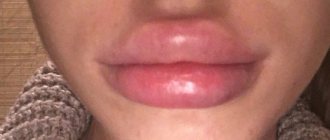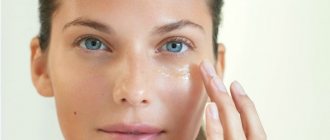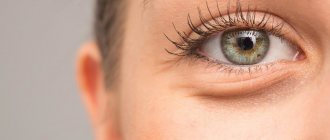From this article you will learn:
- what is the nasolacrimal/tear trough,
- filling the nasolacrimal trough – reviews, photos,
- choice of fillers, possible complications.
Age-related changes in the area around the eyes include: hyperpigmentation, swelling, circles under the eyes, dynamic and static wrinkles, drooping eyebrows, decreased elasticity of the skin of the eyelids, the appearance of “bags under the eyes” (hernial protrusion of fatty tissue), as well as the appearance of furrows. The latter include the nasolacrimal, eyelid, nasozygomatic, and nasobuccal grooves. In this article we will focus in detail only on the correction of the nasolacrimal groove with fillers based on hyaluronic acid.
But it must be said right away that filling the nasolacrimal trough with fillers will be contraindicated for patients with: 1) fatty hernias of the lower eyelids, 2) with excess skin of the lower eyelids, 3) severe elastosis, 4) with allergies to filler components, 5) with infectious process in the eye area, 6) if the patient has previously had silicone, polyacrylamide gel or fillers of unknown origin implanted in this area.
Nasolacrimal trough: photo
This article is written primarily for patients, and is intended to focus their attention on the need to very carefully select a cosmetologist who will perform this procedure. Reviews for correction of the nasolacrimal trough can be very negative. Due to the individual anatomy of this area, it is not always possible to achieve a good result in 1 procedure, and 2-3 procedures may be required. And in some patients, anatomical features may not allow achieving a good result at all.
According to statistics, complications after correction of the nasolacrimal groove develop in 50% of cases, and in most cases are associated with downward displacement of the filler. The latter will lead to the formation of visually clearly visible “sausages” just below the tear troughs and will require longidase injections to dissolve the filler. Less commonly, contour plastic surgery of the nasolacrimal groove can also result in vascular complications, for example, necrosis of the skin of the infraorbital region or irreversible visual impairment. Such complications arise as a result of occlusion or embolism of the angular artery located under the orbicularis oculi muscle (i.e., exactly where the filler is supposed to be removed).
Description of the drug
Teosyal Redensity 2 is a high-quality filler made from hyaluronic acid. With its help, it is possible to combat deep nasolacrimal grooves and dark circles under the eyes. After using the product, the face becomes fresh, and age-related changes can be reversed. The drug is able to correct a whole range of skin defects, including:
- crow's feet;
- hernia of the eyelids;
- dark circles;
- bags under the eyes.
The drug is manufactured by the Swiss company Teoxane. It was founded in 2003. From that moment on, the company began active operations, and its products earned the title of top ones and confidently took leading positions. The manufacturer's preparations are compared with products from the brands Juvederm, Radiesse, and Belotero.
Filling the nasolacrimal trough: reviews, technique
At least 5-7 days before the procedure, it is recommended to discontinue the use of aspirin, NSAID drugs (Ibuprofen, Naproxen, etc.), vitamin E, and drugs with gingo biloba extract. This is necessary to reduce the risk of bleeding and bruising during or after the procedure. Some doctors, in the absence of contraindications, prescribe Dicynon tablets for the same purpose several days before the procedure. Great care should be taken in patients who have previously undergone lower eyelid blepharoplasty for tear trough correction.
It is safest to correct the nasolacrimal groove using a 25G cannula rather than a needle. Carrying out the procedure using a thin 30G needle is also possible, but is considered optimal only in patients after blepharoplasty, because in this case, there are many fibrous adhesions in the tissues, which will be difficult to penetrate with a cannula. It is optimal to use cannulas with a length of 38-40 mm, because the use of short cannulas is much more traumatic and more often leads to vascular complications.
The traditional insertion point for a 38 mm cannula is the intersection of the zygomatic and tragus lines. Anesthesia is required in the area of the injection point, and before anesthesia it is important to apply cold to the injection site, and as an anesthetic to use a drug containing a vasoconstrictor in a concentration of 1: 200,000 (a vasoconstrictor component such as epinephrine or others). Such rules for anesthesia will reduce the risk of bleeding and hematomas.
The classic correction technique is as follows: from the injection site, the cannula moves along the periosteum (i.e., under the orbicularis oculi muscle) to the inner corner of the eye, and during this process the tip of the cannula must be constantly palpated with a finger. The filler is released into the tissue only when the cannula moves backwards in a retrograde manner, and before starting removal it is extremely important to conduct an aspiration test. The injection volume on each side is from 0.2 to 0.4 ml, and will depend on the severity of the tear trough (24stoma.ru).
The upper border of the filler injection area is limited by the lower bony edge of the orbit (the place of attachment of the orbital septum) and, thus, in no case should filler be inserted above the lower bony edge of the orbit. The lower border of filler injection is the nasolacrimal ligament, which is located between the fibers of the orbicularis oculi muscle. Thus, the safe zone for filler injection will be only about 2-3 mm, and essentially a little higher or a little lower, or a little closer to the corner of the eye - literally means “shooting”. At the end of the procedure, it is important to gently massage the area with fingers.
Correction of the nasolacrimal trough with cannula: video
Advantages of using a cannula –
- minimum skin punctures.
- less painful procedure,
- less risk of hematomas and edema,
- there is less risk of embolism or occlusion of the angular artery, which can lead to necrosis of the skin of the infraorbital region and irreversible changes in vision.
The advantages of working with a needle are that correction, even with a very thin 30G needle, carries a significantly greater risk of vascular complications. However, this method also has its advantages, including...
- more accurate dosing of filler volume,
- more precise control of needle tip depth,
- optimal for patients after blepharoplasty (since the needle passes better through areas of fibrosis),
- With a needle, filler can be injected not only horizontally onto the skin surface, but also vertically.
Contraindications
The use of the product is not always possible. Its use should be avoided if:
- individual hypersensitivity to the components of the product;
- diseases in the acute stage;
- violations of the integrity of the skin;
- pregnancy or breastfeeding;
- autoimmune diseases;
- tendency to form keloid scars;
- oncology;
- herpes, cold or flu.
Additionally, correction is not performed on patients under the age of 18 years.
How can fillers remove bags under the eyes?
The main reason for the formation of bags under the eyes is the age-related redistribution of subcutaneous fat packets. The key word here is “redistribution” and should not be confused with “increment”.
Usually the bags are supplemented by a nasolacrimal groove, and its depth depends on the degree of age-related changes and the specific anatomical structure of the face. In fact, the subcutaneous fat layer is depleted in one place and “flows” to another, becoming fixed and accumulating there. The most active growth of fat packets occurs between the ages of 40 and 55+ years.
Bags caused by fluid retention and poor circulation look a little different than age-related fat bags in the lower eyelid area, but often the patient presents with a complex of problems.
The cosmetologist’s task is to use fillers to correct the volume in the lower part of the orbital zone, eliminate “dips” in the area of the nasolacrimal groove, and even out the skin texture of the lower eyelid.
In other words, by adding volume to the area where it is lacking, you can visually even out the area under the eyes.
Composition of the drug
The manufacturer managed to achieve positive properties thanks to the special composition of the drug. It contains hyaluronic acid of non-animal origin. This is the main active ingredient. It fills voids and helps smooth out wrinkles. Additionally, hyaluronic acid normalizes skin color, eliminating bruises and making it look fresher. The absence of animal components reduces the risk of allergic reactions.
To saturate the skin with the necessary substances, the product includes zinc and copper, vitamins, amino acids, and antioxidants. All of them are aimed at normalizing the condition of the affected area, returning it to a healthy appearance, radiance, and increasing elasticity.
The manufacturer understands that injections can be quite unpleasant. Therefore, the product contains lidocaine. This is a local anesthetic that reduces discomfort and sensitivity. As a result, it will be easier for the patient to tolerate the effects.
Photos before and after, choice of fillers –
How to apply filler correctly –
As for the choice of fillers for correction of the nasolacrimal groove, they must have a good degree of plasticity, elasticity and cohesiveness. Below you can see several filler options suitable for this. The duration of the effect of most fillers will be about 6 months, and when using Juvederm Volbella - up to 12 months, because... This filler is made using Vycross® technology:
- fillers of the Juvederm brand – Ultra 2 or Volbella,
- Belotero Balans (Belotero Balance).
Those. In this area, it is impossible to introduce not only fillers that are too dense, but also fillers that are too soft (the latter will be especially characterized by downward migration of the filler). Moreover, we once again draw attention to such a characteristic of the filler as cohesiveness, i.e. the ability of the filler to maintain its shape and position under the influence of the movements of facial muscles. From personal experience, Princess Volume also turned out to be a good filler for correcting this area.
An alternative to fillers for the correction of the nasolacrimal trough –
If after reading the article you are afraid to do this procedure, then this is quite logical. However, there is an alternative to the use of fillers in the form of botulinum toxin. The fact is that injections of botulinum toxin in the projection of the nasolacrimal groove (at two points on each side, 0.5-1.0 units at each point) allows you to relax this area of the orbicularis oculi muscle and, thus, smooth out the contours of the nasolacrimal groove. In addition, this will require only 2-4 units of botulinum toxin, which will amount to no more than 1,200 rubles.
It should be noted that correction with botulinum toxin gives a less pronounced result, but nevertheless leads to a noticeable improvement in the appearance of the periorbital zone. This correction method will be contraindicated, for example, if you often have swelling under your eyes, as well as in some other cases.
Benefits of Teosyal Redensity 2
The use of Teosial Redensity 2 is associated with the following advantages:
- the positive effect is noticeable immediately;
- The product contains additional components that heal the skin and saturate it with necessary substances;
- the presence of an anesthetic in the product makes the procedure more comfortable;
- after using the drug it is possible to obtain a fairly pronounced effect;
- there is no need for long-term recovery.
Preparation, rehabilitation and contraindications
- Rehabilitation after contouring eye surgery with fillers takes 3-5 days. For several days before the procedure and two weeks after, you should not take medications containing aspirin, drink alcohol, go to the sauna, sunbathe, or lift weights. If there is a need for correction, you can repeat the procedure after 14 days without changing the main drug. Contraindications for eye contouring with hyaluronic acid are pregnancy, lactation, herpes, infectious skin diseases and autoimmune diseases.
How is the procedure performed?
Injections with Teosial Redensity 2 are carried out according to the following scheme:
- The patient signs up for the procedure. To do this, simply contact us by selecting the desired time.
- An initial consultation is carried out. During it, the doctor finds out the presence of contraindications and the possibility of performing injections.
- The affected area is treated. An antiseptic is used for this.
- The doctor administers the drug.
- The affected area is treated again.
- The specialist provides follow-up advice, explaining how to speed up the healing process and how to deal with possible side effects.
Compatibility with other procedures
- Eye contour plastic surgery with hyaluronic acid combines well with other anti-aging procedures - such as ELOS rejuvenation, botulinum therapy, thread reinforcement, INFINI volumization.
Composition and principle of action
Mesoai belongs to the group of bioreparants and is intended for correction of the periorbital area (around the eyes) without surgical intervention. The main reasons for the rapid aging of this area:
- Very thin skin with virtually no fatty tissue - because of this, it is almost always overdried, which leads to the early appearance of wrinkles.
- A large number of blood and lymphatic vessels, physiologically predisposed to fluid retention. As a result, there is a tendency to swelling (“bags”) and an unhealthy dark color (“bruises under the eyes”).
Injections have a complex effect on these problematic factors in several areas:
- strengthening the walls of arteries, arterioles and capillaries;
- increasing the tone of small veins, stimulating lymphatic drainage;
- elimination of dryness and preventive moisturizing of the skin;
- protection against a special type of damage - glycation, when under the influence of glucose collagen and elastin fibers gradually lose their elasticity. This leads to the appearance of external signs of sagging skin, and in addition, it becomes extremely resistant to any aesthetic procedures;
- Since in the early stages glycation is considered a reversible process, with minor assumptions it can be assumed that Mesoai not only protects protein fibers, but also restores them.
Unlike injection products containing only hyaluronic acid, the effect in this case is more complex and is due to the action of three main active components at once:
- PeriOrbital Peptide XP2 is a patented synthetic peptide, the main property of which is the normalization of the condition of blood vessels. Relieves spasm of arteries, dilates blood vessels, accelerates blood circulation in tissues. Also, it normalizes the tone of the veins and reduces the permeability of the vascular wall to fluid, which leads to the outflow of blood from the tissues of the periorbital area. It is also “responsible” for eliminating the consequences of glycation in the skin;
- Hexapeptide 17 - another peptide, according to promises, in other words - promotes the gradual resorption of edema and strengthens the walls of blood vessels.
- DRMC complex is a high molecular weight hyaluronic acid with a density of 0.4%, as well as more than 50 amino acids and microelements that help moisturize, tighten and generally improve the condition of the skin. Most of them have proven effectiveness and are regularly used in a variety of cosmetic preparations, mainly in mesotherapy cocktails.
